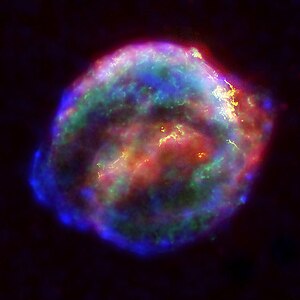SN 1604

A false-color composite (CXO/HST/Spitzer Space Telescope) image of the supernova remnant nebula from SN 1604.
Credit: NASA/ESA/JHU/R. Sankrit & W. Blair |
|
| Other designations | 1ES 1727-21.4 |
|---|---|
| Event type |
Star |
| Spectral class | Ia |
| Observation | |
| Date | 8−9 October 1604 |
| Location | |
| Constellation | Ophiuchus |
| Right ascension | 17h 30m 42s |
| Declination | −21° 29′ |
| Epoch | J2000 |
| Galactic coordinates | G4.5+6.8 |
| Distance | 20,000 light-years (6.1 kpc) |
| Remnant | Shell |
| Host | Milky Way |
| Characteristics | |
| Progenitor | White Dwarf-RedGiant double star system |
| Progenitor type | Type Ia supernova |
| Colour (B-V) | Unknown |
| Notable features | Latest observed supernova in our galaxy. Maintained naked-eye visibility for 18 months. |
| Energetics | |
| Peak apparent magnitude | −2.25 to −2.5 |
| See also | |
| Preceded by | SN 1572 |
| Followed by | Cassiopeia A (unobserved, c. 1680), G1.9+0.3 (unobserved, c. 1868), SN 1885A (next observed) |
|
[]
|
|
Supernova 1604, also known as Kepler's Supernova, Kepler's Nova or Kepler's Star, was a supernova of Type Ia that occurred in the Milky Way, in the constellation Ophiuchus. Appearing in 1604, it is the most recent supernova in our own galaxy to have been unquestionably observed by the naked eye, occurring no farther than 6 kiloparsecs or about 20,000 light-years from Earth.
Visible to the naked eye, Kepler's Star was brighter at its peak than any other star in the night sky, with an apparent magnitude of −2.5. It was visible during the day for over three weeks.
The first recorded observation was in northern Italy on 9 October 1604.Johannes Kepler began observing the luminous display on October 17 while working at the imperial court in Prague for Emperor Rudolf II. It was subsequently named after him, even though he was not its first observer, as his observations tracked the object for an entire year and because of his book on the subject, entitled De Stella nova in pede Serpentarii ("On the new star in Ophiuchus's foot", Prague 1606).
The supernova was also recorded in Chinese and Korean sources.
It was the second supernova to be observed in a generation (after SN 1572 seen by Tycho Brahe in Cassiopeia). No further supernovae have since been observed with certainty in the Milky Way, though many others outside our galaxy have been seen since S Andromedae in 1885. SN 1987A in the Large Magellanic Cloud was easily visible to the naked eye.
Strong present day astronomical evidence exists for a Milky Way supernova whose signal would have reached Earth ca. 1680 (Cassiopeia A), and another (G1.9+0.3) whose light should have arrived ca. 1870. There is no historical record of either having been detected at the time, probably because absorption by interstellar dust made them fainter than they would otherwise have been.
...
Wikipedia
